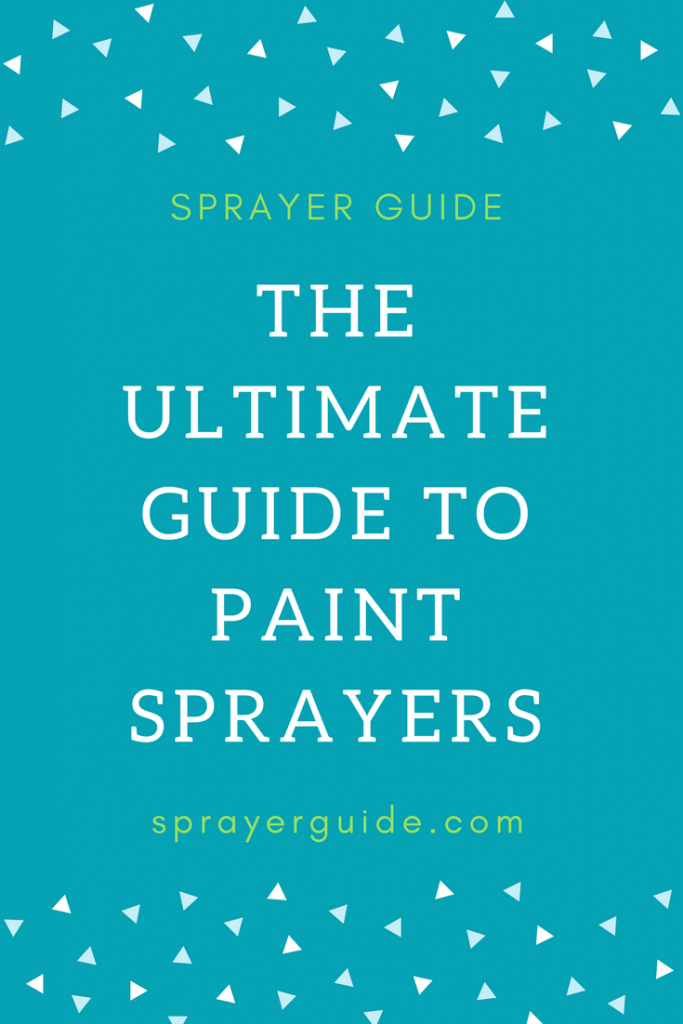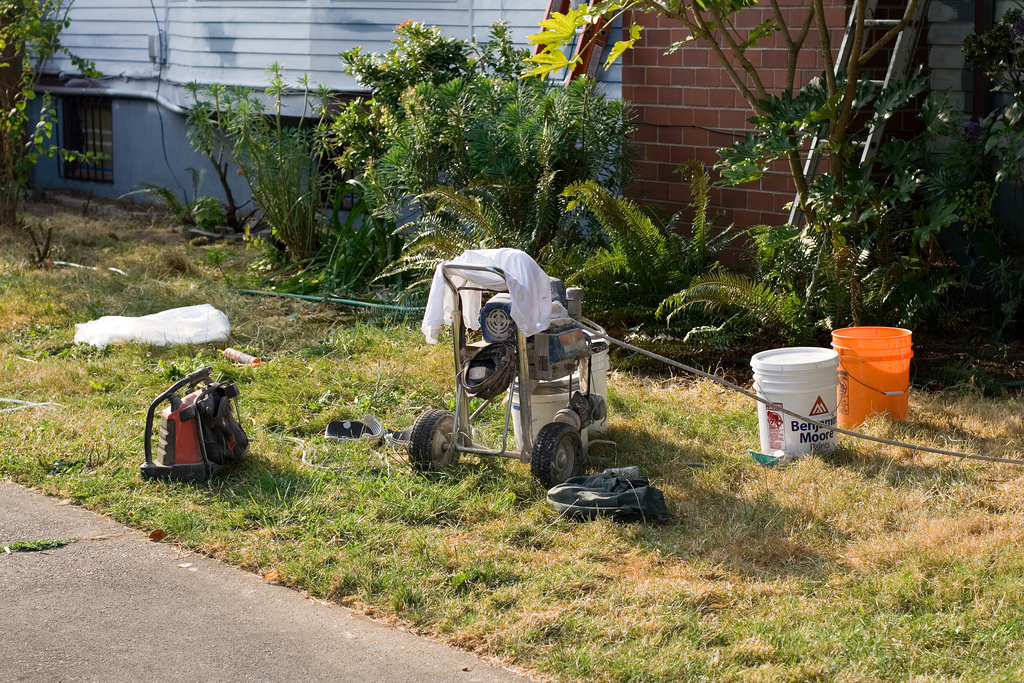Are you looking for the complete paint sprayer guide for beginners? Then you are on the right page.
Look:
If you have ever asked yourself, “what paint sprayer should I buy?” You are not alone.
After browsing through a few forums, it’s not surprising to see posts like this: “How do I select a good paint sprayer for contract jobs?” and many others like that.
In essence, all you need…
…is a comprehensive guide on buying a paint sprayer.
Some of the links below are affiliate links, meaning, at no additional cost to you, we may make a commission if you click through and make a purchase.
Table of Contents
How to Buy a Paint Sprayer (Even If You’re Beginner)
Just like every other thing in life, you can’t get the best unless you put in some work.
If you are a DIYer homeowner or enthusiast, there are many tools you will want to add to your arsenal that you may not have the time to properly research each one.
Even if you have the time, sometimes, certain technicalities may elude you and if you don’t take precaution, you will end up with a mediocre product.
Many of us find ourselves in this kind of situation. And we often seek help from others.
By doing this, we are able to cut down the time, stress, or the research required in purchasing the best product.
This paint sprayer guide has been written for people like me, who not only want to buy the right paint sprayer but want to ensure they are making an informed decision.
This guide will help you buy the best sprayer for your painting needs.
But first, consider this safety measure:
First and Foremost, You Should Be Health and Safety Conscious
When you are working with a paint sprayer/gun, you are exposed to carcinogenic and chemicals, clogging dust, high-pressure fluids, and gasses.
You need to follow the correct procedure and arm yourself with protective equipment and clothing to ensure safety and health.
According to Wikipedia, Foremost in spray paint safety is proper orientation and training for personnel who are responsible for conducting the painting procedures. Acquiring a high level of competence in handling spray paint products is the best measure of preventing injuries and illness in the workplace. It is imperative that sprayers undergo extensive training from a professional training provider or from the product supplier.
See why it’s important?
First Step:
Get yourself a good overall and a strong pair of work boots. Along with this, you will need the following:
- A lint-free, disposable paper overall. Because they are throwaway material, you can discard them when they soaked with paint.
- To protect your hands from getting in contact with paint and solvent, you need to get gloves too, as part of the overall clothing.
- Another important item you need to have is the painters mask to avoid paint coming in contact with your face.
- You will also need simple Googles that will protect your eyes from flying debris or splashing chemical.
- Finally, if you anticipate continuous noise during your operation, you can prevent damages to your hearing by wearing earplugs.
Second Step:
Paints and solvents are flammable liquids and because of this, smoking is highly discouraged in an area that contains these items.
And because your paint station is full of chemicals and dust, eating should be avoided at all cost. It doesn’t take more than a few minutes to clean up and go eat in an appropriate place.
Third Step:
You may need to contact your local authority regarding the disposal of paints or soiled clothes.
This is because it requires planning and monitoring in order to protect the environment and other residents in your locality.
Now:
Question: Why should I buy a paint sprayer?
Consider these:
These Advantages and Disadvantages of Buying a Paint Sprayer
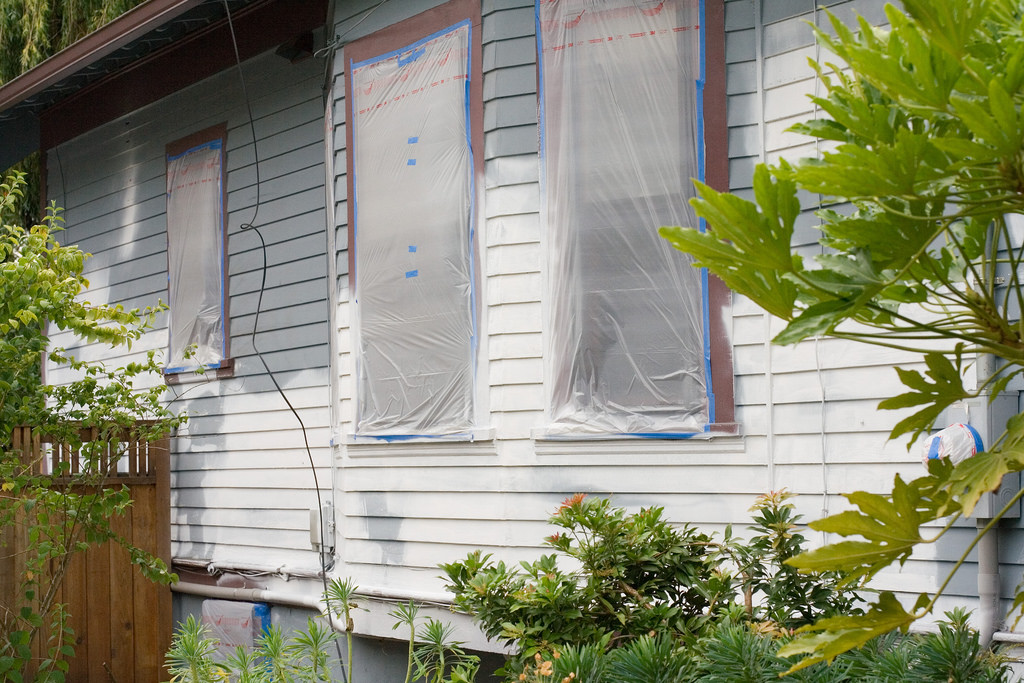
Image: Ocean Yamaha, Flickr
Whether you are a painting contractor, maintenance manager, or a serious do-it-yourself buddy, there are many reasons you would want to buy a paint sprayer.
Of course, there are disadvantages, but after reading this section, you should have a clear understanding of the immense benefits paint sprayers can offer you.
Upsides
- Paint sprayers are fast. Once you get it started and you start painting, you can get a lot done in one go. You could do like a whole room or three or four or five or six or seven rooms in a day.
- Getting in the corners. You don’t have to go into nooks and crannies with a paintbrush because you can just spray around the areas you want to paint and it will cover everything. You don’t have to think about it.
- Nice coverage. It covers nice and even as long as your technique is good. So if you have got a good technique, you can cover a lot of areas very evenly and with a nice finish.
Downsides
- Setup. Getting it up and running takes a while so I consider this a big downside when you compare it to brush and roller.
- Cleanup. Cleaning up sprayers is a chore. It’s not that it’s technically difficult, it’s just time-consuming and not fun. It also takes technique to get it to work properly, it can’t be too close, you can’t be too far away and you can’t be moving at the wrong angle.
Paint Sprayer Guide: 5 Features of Paint Sprayers You Cannot Ignore
Look:
There are many features that come with each of the paint sprayers out there. However, some are just added to differentiate it from previous models or to amplify the functions of the unit.
Sometimes, you may not need these extra features especially if you are not a regular user.
Instead of going through all these features, some of which may not be that useful, there are only a few you should look out for whenever you are buying a new sprayer:
1. Portability
You can use a portable paint sprayer irrespective of the size of the project. Portable ones can be used both outdoors as well as in the shed.
You can add wheels or a backpack to get more free movements. Light-weight and portable sprayers are easy to use.
To prevent accidental spray, it is better to use a safety-catch or a trigger-lock. This becomes useful when you are moving around with the sprayer.
2. Power
A sprayer, just like spray bottles are controlled by hands. Depending on the kind of delivery system, you may go for power, cord-less or fuel-powered options.
Apart from a power source of the sprayer, an additional power source for a compressor may be needed in certain cases.
You have to keep this in mind while you shop.
3. Flexibility
An important feature of a sprayer is its flexibility. Some are adjustable while others offer speed settings.
The thing to look for in your sprayer is whether it is flexible enough to meet your varied needs. Some sprayers have output control system for accurate regulation of paint.
You may need a different layer of thickness or different patterns.
Generally, you go for sprayers which apart from paint give you veneer and glaze to the material on which they are applied.
4. Spray Pattern
There may be variation in spray patterns. The less expensive sprayers have smaller turbines producing a foggy and spread out edges. Also, large paint spatters are formed.
Thus the kind of turbine used is important.
Good paint sprayers give you a tight spray pattern and there is minimum spray beyond the edges. This gives you a better and smooth finish.
So before choosing to check out the kind of spray patterns the machine produces.
5. Clean-up
This part is time – consuming as well as messy. You need to flush out after you are done with, and taking apart a sprayer takes time.
Some sprayers are so made that you can attach it to your garden hose and flush it quickly. This makes less mess.
These are then the five features to check before buying a paint sprayer.
Next is the kind of tasks executed by these sprayers. Paint sprayers are used both domestic as well as for commercial purpose.
The 4 Crucial Jobs a Paint Sprayer Can Do That Your Roller Cannot
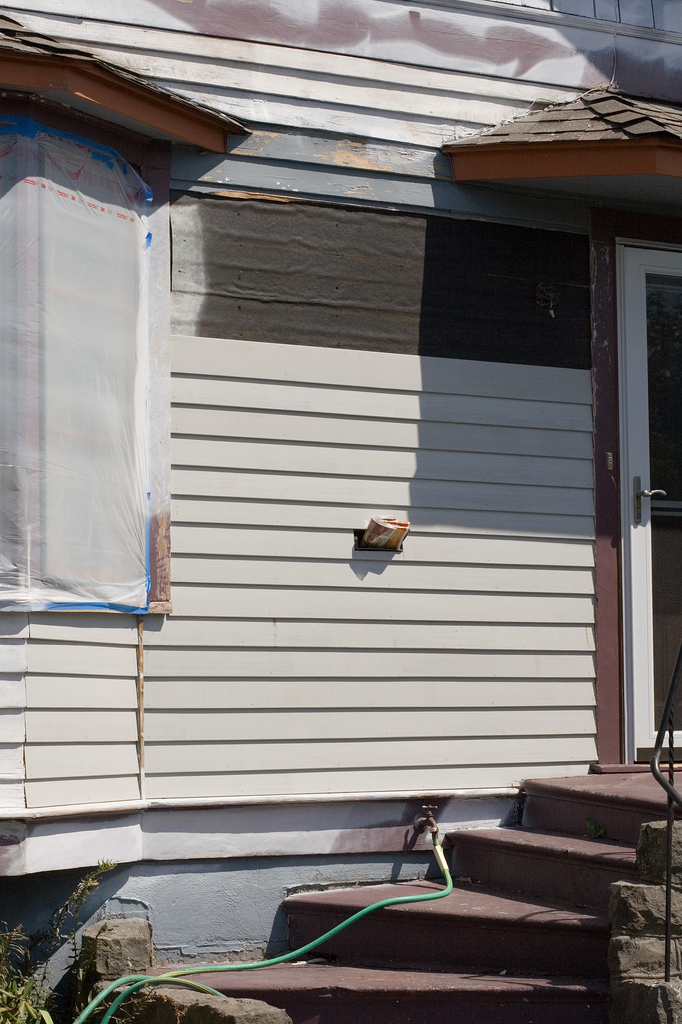
Image: Ocean Yamaha, Flickr
Here we concentrate more on the domestic tasks performed by these Paint Sprayers.
Some of these may be applicable to you if you are a home user and others may not appeal to you. Also, if you are a contractor or professional handyman, you will find some are more applicable to you than others:
- Large covering area – one of the biggest advantages of using a paint sprayer is that you can cover a large area using it. If you compare brushes or paint rollers, sprayers let you cover large swath in no time. You save time in that process with less labor. You get an even coat using sprayers; something that you cannot achieve with a brush. You only need to look out for overlapping, just like in the case of paint rollers.
- Override rough textures – as you work on any surface, you are bound to face imperfections such cracks, bumps or gaps. These surface imperfections are overridden by using paint sprayers. These things are hard to override using rollers or brush.
- Painting multiple surfaces – paint sprayers are very useful when you have to paint multiple surfaces with the same color. You may want to paint the walls, ceiling, and trims of your room with the same color. Use sprayers to get better results. You can mask-off or cover the part you do not want to be colored. While doing precision works, a prep work in advance would definitely help.
- Industrial Painting – paint sprayers are widely used in different industries for commercial purposes. It is used for top coating metal parts and spraying plastic applications. Automobile industry uses special sprayers for coloring different automobiles. In fact, paint sprayers are used in different industries to execute different tasks.
Types of Paint Sprayers (We’ll Cover A 5 Paint Sprayer Types)
There are many paint sprayers out there…
…and each one has a specific task it is suitable for.
For example, airless paint sprayers are versatile and are useful for a variety of applications. Knowing what each type does will help you decide which one is for you depending on the task you will be using it predominantly for.
Let’s go over each type for your benefit:
#1. Airless Paint Sprayers
This type of paint sprayers are the most versatile ones. They can be used for both large commercial projects and smaller jobs. These sprayers utilize paint under high pressure and the overspray is very less over here.
Whether or not you should use this sprayer for your painting job depends on what type of surface you will be painting on.
This one works best with thick latex paints or thinner stains. The Airless paint sprayer comes in handy for painting exteriors as well as spray painting the interiors.
Be careful in using the right tip for this sprayer which depends on the size of the surface you will be spraying on.
The sizes of the sprayers, guns, and tips, all matter a great deal when it comes to performing a painting job well. This sprayer is coupled with a diaphragm or piston to spray the paint.
It is also suggested that the spraying distance should be always maintained at around 12 inches or more. This will ensure lesser health concerns for you.
#2. Cup Sprayers
Cup sprayers are a special category within Airless Paint Sprayers but are perfect for smaller jobs. Mainly used for touch-ups or finishes, these paint sprayers are very simple to use.
All you have to do is fill them up with paint, plug them into a power point and start spraying.
DIY projects are usually accomplished by this type of sprayer.
It deviates from the Airless sprayers in the fact that Cup sprayers require masking always. You will also have to use thinners for the paint before spraying.
Some Cup sprayers also come with attachments that siphon paint straight from the bucket instead of the cup. They are the most affordable among all type of paint sprayers and are highly recommended for beginners.
#3. HVLP Paint Sprayers
HVLP paint sprayers use a high volume of air in a low-pressure environment to spray the paint. The paint is sprayed uniformly onto the surface and this sprayer can be used for some of the more detailed work.
It is best for small projects and where you need greater control and precision.
You will need to use paint thinners before you transfer it into this paint sprayer. It cannot be utilized to spray thick lacquers or varnish paints. The paint travels very slowly to the surface from the sprayer and that is why provides a smooth finish.
These paint sprayers do not overspray or splash back, so lesser paint is wasted than other sprayers.
However, these are costlier sprayers and are very good with interior projects like spraying of a door or cabinet. It will pass any close inspection of spills.
#4. Compressed Air Sprayers
These types of sprayers use high-pressure air column to spray the paint evenly onto the surface. These sprayers are also very versatile and can be used for small and large projects alike.
You will need an air compressor in order to use this paint sprayer.
Though it is not very expensive, it creates a mess of paints all around the work area. Overspray is common and spillage of paint is more than the other sprayers available.
Therefore, the amount of paint needed to complete a job is usually more than what other sprayers need. Also, you will inhale a lot of paint during the spraying which is not good for health purposes.
Professional contractors avoid this kind of sprayer as it is messy and hazardous.
#5. Electrostatic Paint Sprayers
This type of paint sprayer uses an electric charge to spray the paint. There are two types of techniques used in this type of spray painting.
Contact charging method charges the paint directly before it sprays on the surface and bombardment method atomizes the air particles which in turn electrically charge the paint to be sprayed from the gun.
All types of the above-mentioned sprayers like Airless sprayers or Compressed Air Sprayers or HVLP’s can be used for the spraying of the electrostatic paint. However, you need to purchase a specialized gun.
Electrostatic Paint sprayers are extremely costly and are used by industrial or commercial contractors.
The auto industry uses these types of sprayers for the painting of cars. It offers a smooth finish and uses much lesser quantities of paint for the same job. The Electrostatic spray painting method is itself a pleasurable experience.
The charged powdered paint sticks to one metal type which is grounded like the magnetic effect. However, the area that needs painting should be degreased several times to allow the paint to stick.
Also Read: Our guide on paint sprayers for house exteriors
Question: But what makes these paint sprayer types different from each other?
Let’s see a few differences:
The Differences Between Airless, HVLP, and Hybrid Sprayers
If you didn’t watch the video:
You’ve probably realized there are many types of sprayers and are now not sure which sought to buy. This simple paint sprayer types comparison will help you select the right machine for your purpose.
There are two predominant methods of spraying paint: airless and HVLP (high-volume low-pressure).
Airless Sprayers:
The airless method puts the paint under pressure and forces it through a small tip in the gun which atomizes the paint. This method is ideal for large areas and for thicker products such as emotions and masonry paint.
Airless machines make quick work of large areas, machines use a piston to pump the paint and some units use a diaphragm but the end result is the same.
Machines are rated by the thickness product that they will spray you may see the term 515, 517 or sometimes more – this is the size of the hole in the tip that they will support.
The less you need to thin the paint the better so the larger the hole, the easier it is to achieve a satisfactory job.
Different tips that can be inserted into the gun changing the tips will give you various fan whips and better flow.
For example: if you want to spray with a wood preserver you would not necessarily want the same tip that you would use for masonry paint because the hole in the tip called the orifice would be too large and too much preserver would come out.
Conversely: using a small tip to spray masonry paint would mean the pump would have to work harder to force the painter through and you would not get a satisfactory finish resulting in an uneven fan known as fingering.
Filters are used in the gun to stop particles of dirt blocking the tip.
HVLP Sprayers:
These kind of sprayers use air to atomized the paint it produces a fine finish and is better suited to thinner products such as gloss, eggshells or wood preservers.
HVLP will give you a fine finish but the volume output is low. There are also hybrid units such as the WallPerfect range that sit in the middle and offer a bit of both so there you have a quick overview.
HVLP units are very simple. The more air they produce the better and this is why they vary in the amount of paint you will need to thin down to spray.
How much depends on the airflow and the product but as a general rule if the gun spits, then thin it more.
But Wait…there is another type you should know too…
Hybrid Sprayers:
The hybrid systems generally use HVLP to atomize the paint but because of the engineering in the gun, they pick up emissions very well by changing the gun over to a conventional one.
The same machine can be used for the trim finishes so there you have it a simple overview of spray types.
What if you already have a paint sprayer? Learn how to get the best from it:
How to Use and Maintain a Paint Sprayer for Long Lasting Performance (In 12 Easy Steps)
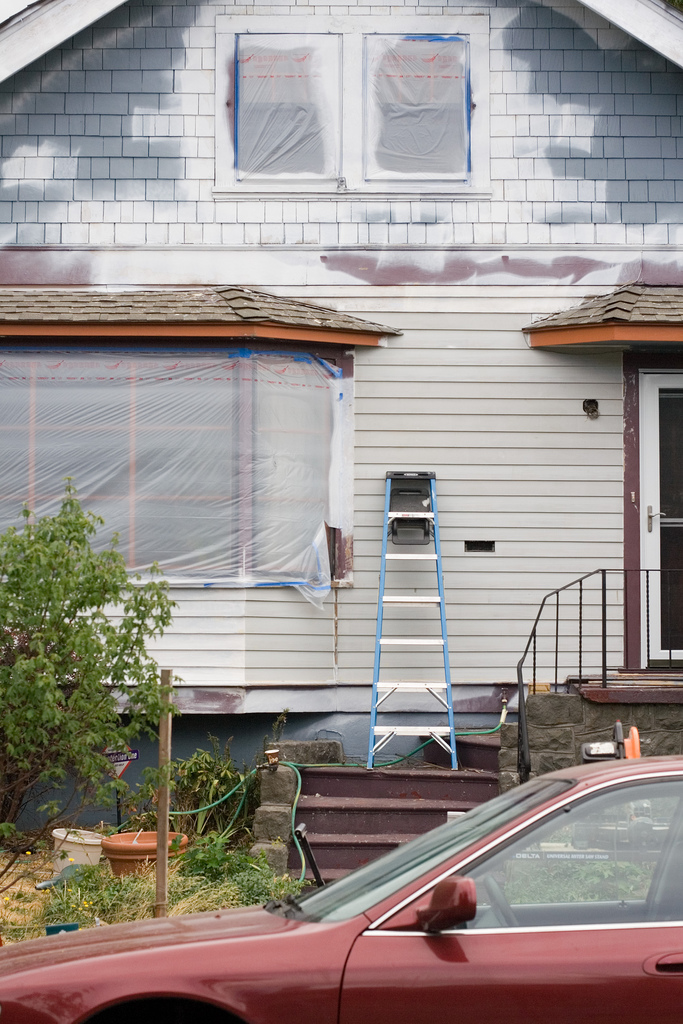
Image: Ocean Yamaha, Flickr
Maintenance is very important, especially if you are using a tool that prone to rust.
If you take good care of your sprayer and ensure routine maintenance, you will be able to use it for a longer period. In this section, you will learn how to use your sprayer and tips on how to get the most out of it.
Let’s get started:
How to Use a Paint Sprayer
A paint sprayer is a better option than using roller or brush if you want to spray with ease and speed. Using a paint sprayer is an art that needs to be learned through dedicated effort.
There are various techniques a person needs to follow in order to paint the desired object perfectly. Further, a person should have steady hands and must be dexterous in his skills.
- Before knowing how to start painting using a paint sprayer, one should cover all the objects, like, floor, door, tables, and windows; with plastics to avoid paints stains on them.
- Next, the person needs to have the feel of the sprayer gun. He should get used to how light or heavy the gun is so that he can time his motions accordingly while spraying the surfaces.
- The paint gun should always be moved parallel to the surface, making arcs with your hands is not recommended as it makes drips.
- Drips should be avoided at all cost because it makes the area look embossed. However, if drip happens you should have a brush ready in hand to smooth the drip over.
- Further, the motion of the gun should be fast to avoid runs. One should be familiar with the gun being used because it helps to time your motion and let the spray spread evenly on the surface.
- Finally, the gun should be held perpendicular to the surface, making a 90-degree angle with the surface.
How to Maintain a Paint Sprayer
There are many other tips on how to maintain a sprayer out there. This list is not to be taken as the complete list. As time goes on, more tips will be added to these:
- The primary maintenance of paint sprayer involves using thinners to keep the tubes and rods wet and clean. So that residue from previous paint is dissolved.
- The thinners are used to clean and wash-up oil based or latex based paints. Use of two bucket water method is also recommended to help purge the dirty water from the tubes into the dirty bucket. The clean hot-soapy water is also rinsed through the tubes at full pressure.
- Thinners are also great if you decide to not use the sprayer for a long time. It not only protects the sprayer gun from cold weather conditions but keeps the pump and tubes from breaking or leaking.
- Another thing to look for is the condition of the sprayer’s nozzle or tip. A tip that is worn out will spray inefficiently, causing drips in the middle of spray. It also causes you to use more spray than it is required.
- There are many O rings in the paint sprayer that needs to be checked up regularly, for cracks and scratches. It is pertinent to do this because it helps avoid disturbing the flow of spray pattern or at worse stopping your pump to work altogether. The main areas where O rings are found include the tip, in the wand extension, and pump housing.
- Keep a separate assortment of filters for varying applications, for example, using a gun filter or machine filter for tasks like painting your car, or wall painting etc. Keeping these different filters handy will make sure a longer lifespan for each one of them.
Also Interesting: Stain sprayers for decks
Top 6 Accessories to Pump-up Your Paint Sprayer
Do you know:
Paint sprayers cannot do without some accessories.
Yes, that’s true…
…some of these are basic while others are available to amplify the functions of the paint sprayer.
You don’t necessarily have to buy any of these for your sprayer, but at some point in the future, you may decide to get them to be able to enjoy your spray to the fullest.
Here they are:
#1. Paint stir paddle
Paint stir paddle comes in different sizes, strength, and coloring. It is used for waxing, shims, crafts. This accessory allows for easy writing on a smooth surface
#2. iSpray front end
The iSpray front end is used for both exterior and interior surface. It provides speedy coverage and makes the spraying more precise. It comes with 4 pattern settings i.e. vertical, horizontal, wide and narrow.
#3. Detail finish front end
This accessory is used for projects which require finer finish i.e. furniture, cabinets, and crafts. It can be used in combination with sealers, stains, and polyurethane coatings.
#4. Airless spray hose
This hose is highly flexible which makes it easy to spray under pressure. It is also lighter which helps in timing the motion of hand to spray smoothly.
The hose also has reduced coil memory so that you can coil it firmly without worrying about breaking the hose.
#5. Spray gun cleaning kit
This kit includes brushes of all sizes to clean individual parts of the spray gun.
It has brushes like; external detailing brush, spray gun brushes, tube cleaning brushes, body cleaning brushes, and brushes for the fluid tip, air cap and baffle among many other mini accessories.
#6. Duckbill valve
Duckbill valves are a one-piece, elastomeric component that acts as backflow prevention device They have elastomeric lips which prevent backflow and allow forward flow.
An elastomer is polymer having high elasticity and viscosity and very small inter-molecular forces.
There you have it…
Remember that this guide is a step towards buying the right paint sprayer for your painting needs. There are a lot of other things you may want to consider before buying the next sprayer.
However, the ultimate paint sprayer guide contains as much information as you will need to make an informed decision.
